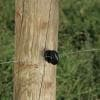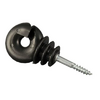Thank you, this is great information. I am curious to hear more about the Tamworths since they can help with soil preparation... In your experience, how do they compare to the Kune kunes on size, lard content, disposition, breeding, taste, etc.
Durham Dad,
As my CFF name implies, I love farming wisely. And have put a lot of thought and think deliberately about how I do things. I try to merge philosophy with agriculture in a way that is in line with folks like Wendell Barry, and the Vanderbuilt agrarians. I'm a bit of a romantic (40 acres and a mule and all) and an idealist (known to duel windmills) and I can get chatty, so getting me goin on husbandry and working the land isn't hard, its getting me to shut up that is the problem. There is so much here though......
Cool resource first:
So I'll point you and anyone interested in the history of farming in the US in the direction of the American Livestock Breeds Conservancy. They are a wealth of information and based out of Pittsboro, NC. They have history behind rare breeds and a lot to say about how each has served our ancestors over the years. They call them "heritage breeds" and their emphasis is on the preservation of these important and historical breeds many of which are endangered and a critical numbers. You'll be amazed at the breeds of any type of animal you've never heard of and you'll wonder why they aren't on every small farm. But the truth is,they use to be. There are a ton of breeds of turkey, sheep, and cattle that are fantastic and far better suited for small holders than commercial breeds. For instance, you can get more milk
per acre from little Dexters than Holstein. They don't fit into the model of milk
per cow which has been more doable on a commercial dairy of scale, but the small holder just wants a sufficient amount of milk for a limited amount of land to feed himself, and a handful of neighbors. I went to Tillers International to learn to work with oxen for animal traction (plowing and logging) about 10 years ago and got to work with a rare breed called Dutch Belted (not Belted Galloway but looks similar) that is ideal for milk, meat and fantastic for labor. Dutch Belted produce almost the same butterfat as a Jersey and will do it on poor Pasteur conditions. But with specialization of Hosteins for milk, Angus for beef and no need for smart labor (oxen) a lot of the great all around breeds just fell of the map, the Milking Shorthorn and the Milking Devon come to mind as breeds that were multi use which are now bred primarily for beef. Others lost their smarts being bred for meat production etc. Anyway the question wasn't about cattle, but principle is the same. My point is that, smallholders and homesteaders need not be limited and boxed into the breeds or models of bigger commercial farms. Can't recommend the ALBC more.
Tamworth and Kune Kune Contrasted:
Tams are much larger than Kune Kunes by a couple hundred pounds, they are a bacon breed rather than a lard breed (bacon breeds have long rectangular fit looking bodies and lard breeds look like fat round footballs). Tams are very vigorous rooter-a-rounders and are fantastic if you need to eliminate weeds and vegetation on a future garden site. They will go to turning up sod without pulverizing the microbiology of the soil like a mechanical tiller will, which keeps the soil healthy facilitating nutritional uptake by the plants you intend to grow. The advantage to this in conjunction with a manual broad-fork or turn or chisel plow over mechanized tilling is that you sequester water, nitrogen and avoid dead pan. You get all this all while your pigs fertilize as they go and eventually provide you the benefit of a far superior healthier pork than something raised on concrete or wire floors. Farming is a ballet of material and figuring out how systems can compliment other systems. This "pig tractor" method is a temporarily fence em' ( w/ short electric netting) and let them do the work for you type of approach. As Joel Salitin says, your employing the "pigness of the pig." Tams have a long powerful plow of a snout.
Kune Kunes are smaller, they are little wooly footballs. They have fantastic pure white lard. They are docile. They are far more personable and approachable. Both taste good to me, we do a lot of sausage and bacon (I have a slicer for after we have smoked the belly). I prefer the size and taste of a Kune Kune ham. Its flavorful and doing one fresh ham wont leave you with ham leftovers for 3 days. You'll get more of the "choice cuts" from a Tam because of the long body and top loin and you'll get larger portions of choice cuts owing to their larger size. Kunes have a short dished nose much like the potbellied pig's which limits their ability to root around (they still do some rooting). Instead they graze, which is great if you are interested in a more grass based approach to supplementing feed. In fact you have to really limit feed with Kune Kunes. The green herbage consumption makes unique pork and there is a growing charcuterie market for this (though I have not messed with this yet). I have not run into any problem breeding the Kunes so long as the boars aren't overweight; I can not speak to the Tam's ease of breeding, we got those as piglets and just did them as growers. Given they are a bacon breed and very vigorous/active you shouldn't have any problems with the breeding. One of the reasons we went with Kunes was that they are small enough that keeping a boar was more feasible cutting down on breeding and the mark up from getting piglets every year. But having an on site boar for breeding can bring some challenges that are not always worth having over just finding a supplier of feeders when it comes to a large breed. I would say though, if one of the goals is turning up soil, having a Tam sow or two that you take to get bred and overwinter, might be a good option because its the larger stronger pigs that are going to do the heavy lifting when it comes to tillage. Lastly, Kunes are right at home in an orchard and help keep down the grass and eat premature deadfall before worms set in.
While not exactly an orchard with fruit, I have a stand of 4 year old Dunstan Chestnuts that will start bearing soon. Prior to the American Chestnut Blight in 1905 when a squirrel could go from Georgia to Main from one Chestnut to another, many "swine herders" in the Appalachian free ranged branded hogs all over the mountains. We are talking hundreds of pounds of nut mast dropping from just one mature tree and they were 1/3 of the forest canopy. They rounded them up after they had foraged and "finished" on the seasonal Chestnut drop in the fall and would drive them down the mountain to Wilkes to market. This would have fattened hogs up real good right before slaughter time. Some of the earliest laws on record in Blowing Rock had to do with fencing pigs. Rich Folk in Blowing Rock didn't approve of these ranging hogs in their fancy yards. I might not let them have free range of the nuts in the orchard, but might store them for over winter feed if I can figure a way to preserve and keep them. I have about 60 Chestnut trees so I should have plenty for them, the deer we hunt and us (chestnut flour and polenta).
With all my pig systems I use either movable short premier fence netting or old fashion electric wire and have small moveable huts. Water solution is a free food grade 55 gal drum with a nipple screwed directly into the bung. I have these on some wooden stands so I can get them up off the ground at snout height. This system is easy to move manually or with a small truck. My huts are build on skids as is the water sled station which is filled by the rain coming off the hut. Rarely have to bring water in. As stated before, shade from sun is important with any pig. Lots of folks have great luck "foresting hogs" with the larger breeds by drilling insulative donuts into trees and confining them to the shade. They eat the undergrowth stay in the shade and grow way faster when not stressed with heat. They lay in the cool forest soil and can be provided a free choice hopper. But don't ever give Kunes free choice. They will get so fat so quick it can effect fertility. I know a guy who does the forest hog thing and he has a trailer full of 600 pounders going to the market in shifts. He farms a lot of different stuff, but the money making is in Hogs and they are the easiest thing to manage of all his critters and produce.
Hope all this helps. I've got lots of fun things to offer folks that are interested from my years "philosofarming." I have learned most of my lessons and tips from researching tried and true historical methods, watching others, or by trial and error. I've made every mistake possible and don't mind sharing my mistakes so you don't have to make them too. There isn't much I have not tried my hand at homesteading wise or can't speak to or research for inquiring minds. Let me know if there are any other burning questions. I will try to start new threads when I have new projects coming up.




